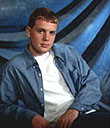|
|
This topic comprises 4 pages: 1 2 3 4
|
|
Author
|
Topic: Aperture plate filing
|
|
|
|
|
|
|
Brad Miller
Administrator

Posts: 17775
From: Plano, TX (36.2 miles NW of Rockwall)
Registered: May 99
|
 posted 01-27-2000 11:39 PM
posted 01-27-2000 11:39 PM




If you absolutely MUST file that plate a bit, go spend some bucks on some real aperture files. The files you can find at Sears are rough on all edges, and while you are working on a corner, you will be cutting into the next side! Also, remember if you're wanting to open up the top right corner as it is projected on the screen, you want to cut on the lower left hand corner of the plate, as the lens flips the image.Before you go cutting on a scope aperture, check out the "Focusing Anamorphics" tips on the front page of this site. Many times the focus will get just a touch off and will "shrink" the image on screen to produce a shadow. Finally, remember that once you file, there is no way to put what you cut back! So be reeeeeal careful.
| IP: Logged
|
|
John Pytlak
Film God

Posts: 9987
From: Rochester, NY 14650-1922
Registered: Jan 2000
|
 posted 01-28-2000 09:16 AM
posted 01-28-2000 09:16 AM





Whatever you do, always use the SMPTE 35-PA (RP40) test film to verify that you are projecting as close as possible to the correct image dimensions. Per Standard ANSI/SMPTE 195, the projectable image area for "scope" is 0.825 X 0.690 inches (20.96 X 17.53 mm). The projectable image area for non-anamorphic (1.85:1 aspect ratio) is 0.825 X 0.446 inches (20.96 X 11.33 mm). The 1.66:1 aspect ratio is 0.825 X 0.497 inches (20.96 X 12.62 mm), and the "Academy" 1.37:1 aspect ratio is 0.825 X 0.602 inches (20.96 X 15.29 mm). Test films and standards are available from the Society of Motion Picture and Television Engineers, http://www.smpte.org ------------------
John P. Pytlak, Senior Technical Specialist
Worldwide Technical Services, Professional Motion Imaging
Eastman Kodak Company
Research Labs, Building 69, Room 7419
Rochester, New York, 14650-1922 USA
Tel: 716-477-5325 Fax: 716-722-7243
E-Mail: john.pytlak@kodak.com
| IP: Logged
|
|
|
|
|
|
John Pytlak
Film God

Posts: 9987
From: Rochester, NY 14650-1922
Registered: Jan 2000
|
 posted 01-28-2000 02:30 PM
posted 01-28-2000 02:30 PM





Martin:Some of the SMPTE 35-AT (RP110) test film that is in circulation is quite old, and was made before the current dimensions were adopted. In particular, the anamorphic image width has been narrowed from 0.839 to 0.825 inches, and the anamorphic height has moved from 0.715 to 0.700 to 0.690 inches. Using the old dimensions risks showing the DTS track on the screen, and will show more "flashes" at splices. I believe SMPTE is updating RP110 and the 35-AT film to agree the current dimensions specified in ANSI/SMPTE 195 and RP40. I suggest you get some new SMPTE 35-PA (RP40) so there is no question. ------------------
John P. Pytlak, Senior Technical Specialist
Worldwide Technical Services, Professional Motion Imaging
Eastman Kodak Company
Research Labs, Building 69, Room 7419
Rochester, New York, 14650-1922 USA
Tel: 716-477-5325 Fax: 716-722-7243
E-Mail: john.pytlak@kodak.com
| IP: Logged
|
|
|
|
|
|
John Walsh
Film God

Posts: 2490
From: Connecticut, USA, Earth, Milky Way
Registered: Oct 1999
|
 posted 01-30-2000 08:02 PM
posted 01-30-2000 08:02 PM




Yes! The light photons push the brass filing away from the projector....In this part of the universe, however, I find that the hole gets smaller. I think the action of getting hot, then cold, then hot, etc. closes the hole slightly. Also, in new theaters, as the floor settles, the projector might tilt down just a little. That causes a very slight shadow, usually at the top, after a few months.
| IP: Logged
|
|
|
|
|
|
John Walsh
Film God

Posts: 2490
From: Connecticut, USA, Earth, Milky Way
Registered: Oct 1999
|
 posted 02-06-2000 06:14 PM
posted 02-06-2000 06:14 PM




Tim's got the right idea: check it first.
There are no SMPTE standards for how much should overlap onto the masking. But, it would be hard to define that. If the aperture is close to the film, you can get a pretty sharp transistion from "white light" to black. If it's far away, you may need to file it out more to insure there is no shadow on the screen. Centurys seem to hold the film away farther than Cinemecannicas, so you need to file Centurys a little more.Picky people want it as little as possible, but generally will accept about 6" of spill. I personally would allow up to 12" because I had too many screens to keep running, and don't want to come back to places where the bottom masking drooped, or the projector settled, etc. Except for 70mm runs, where I would keep it at 6".
| IP: Logged
|
|
|
|
|
|
All times are Central (GMT -6:00)
|
This topic comprises 4 pages: 1 2 3 4
|
Powered by Infopop Corporation
UBB.classicTM
6.3.1.2
The Film-Tech Forums are designed for various members related to the cinema industry to express their opinions, viewpoints and testimonials on various products, services and events based upon speculation, personal knowledge and factual information through use, therefore all views represented here allow no liability upon the publishers of this web site and the owners of said views assume no liability for any ill will resulting from these postings. The posts made here are for educational as well as entertainment purposes and as such anyone viewing this portion of the website must accept these views as statements of the author of that opinion
and agrees to release the authors from any and all liability.
|

 Home
Home
 Products
Products
 Store
Store
 Forum
Forum
 Warehouse
Warehouse
 Contact Us
Contact Us




 Printer-friendly view of this topic
Printer-friendly view of this topic


















